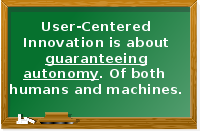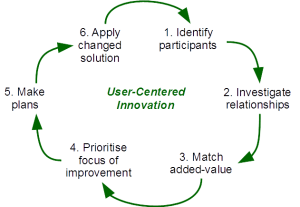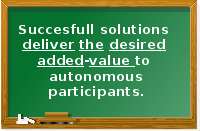Innovative solutions guarantee the autonomy of their participants

User-centered innovation addresses the solution as a whole.
In the past 20 years we’ve engineered socio-technical solutions in which both humans and machines participate. Examples abound, e.g. social-apps, public transit electronic ticketing, B2B e-commerce, online shops. You’d think we now know how to make it work, right? Well… often we do not. So, what’s happening?
When investigating successful innovations the key ingredient is that these solutions guarantee the autonomy of the involved humans and machines. Guaranteeing autonomy requires thinking in terms of added-value among participants in the system: Delivered added-value ought to match with desired added-value. User-centered innovation starts with commonsense and is technically feasible.
NEXES KPS Lessons Learned (final blog series)
 The NEXES Research and Innovation Action is in its final month in April 2018. Having applied the Flexible KPIs in two major pilots and small demonstrations, there is ample experience to formulate lessons learned and recommendations on the application of the Flexible KPIs. To this end, a ‘final’ series of five articles has been written that touch on the application of the Flexible KPIs, monitoring and planning, exploitation and more. Read more…
The NEXES Research and Innovation Action is in its final month in April 2018. Having applied the Flexible KPIs in two major pilots and small demonstrations, there is ample experience to formulate lessons learned and recommendations on the application of the Flexible KPIs. To this end, a ‘final’ series of five articles has been written that touch on the application of the Flexible KPIs, monitoring and planning, exploitation and more. Read more…
Recent blog posts
 Do you wish to see the overview of blog posts? |
NEXES blog series on Key Performance Indicators
 Within the NEXES Action the need arose to address the proverbial challenge of “Comparing Apples and Oranges”. Instead of imposing a strict set of key performance indicators (KPIs), a more flexible approach was adopted. These flexible KPIs are defined to respect the autonomy of the involved parties. A series of six articles has been written that discuss the challenge, explain how not to compare apples and oranges, and describe the adopted solution to compare apples, oranges and any other fruit. Read more… See also the animations on YouTube NEXES NG112.
Within the NEXES Action the need arose to address the proverbial challenge of “Comparing Apples and Oranges”. Instead of imposing a strict set of key performance indicators (KPIs), a more flexible approach was adopted. These flexible KPIs are defined to respect the autonomy of the involved parties. A series of six articles has been written that discuss the challenge, explain how not to compare apples and oranges, and describe the adopted solution to compare apples, oranges and any other fruit. Read more… See also the animations on YouTube NEXES NG112.
Focusing on all participants in the solution
In user-centered innovation the focus is on the entire ‘solution’ in which both humans and machines participate. Here, ‘solution’ refers to a socio-technical system where the joint actions of the humans and machines drive the overall performance. The solution is in place to resolve a ‘problem’ that would otherwise exist. This problem can be real (as in, an explicit need for a service or product) or implicit (as in, that a potential client was not yet aware of a service or product). Read more…
Benefits & Investment
 The application of user-centered innovation has at least the following benefits:
The application of user-centered innovation has at least the following benefits:
- Greater appreciation of the solution and overall performance.
- Greater accommodation of individual differences in humans and machines.
- Solution is built to change: straightforward to add/remove/update participating humans and/or machines.
For additional benefits and the required investment: Read more…
Autonomy
Autonomy is a concept with many nuances. Here, autonomy is meant to mean: the entity itself decides what to work on, when, where, for whom and with which resources. This kind of self-governance is well-known to be very important. The mechanisms by which autonomy is manifested are, of course, quite different between humans and machines. Yet, by explicitly recognising that both have autonomy it becomes simpler to analyse, design, model and realize useful solutions. Read more…
Added-value
When interacting with autonomous participants it makes sense to make the content of the interaction ‘worthwhile’ for these participants. After all, there is a reason why this interaction takes place. That reason is about the perception of added-value: the involved participants get ‘something’ out of the interaction that they like (or desire, need, must have to complete a task, etc.). Added-value is a subjective opinion: each participant has an individual opinion on whether ‘something’ has added-value. Read more…
Methodology
 User-centered innovation is accompanied by a methodology that makes explicit what needs to be improved to arrive at a higher performance level of the solution. This methodology takes all participants into account and aims for a joint prioritisation of improvements. The user-centered innovation methodology does not prescribe beforehand how to build or adapt your behaviour, machines, and/or participation in the solution. Rather, when applying this methodology each participant is enabled to understand the relationships with other participants and the areas for improvement. Each participant can, and should, continue to use their own priorities, metrics, workflows, development cycles, et cetera. Read more…
User-centered innovation is accompanied by a methodology that makes explicit what needs to be improved to arrive at a higher performance level of the solution. This methodology takes all participants into account and aims for a joint prioritisation of improvements. The user-centered innovation methodology does not prescribe beforehand how to build or adapt your behaviour, machines, and/or participation in the solution. Rather, when applying this methodology each participant is enabled to understand the relationships with other participants and the areas for improvement. Each participant can, and should, continue to use their own priorities, metrics, workflows, development cycles, et cetera. Read more…







